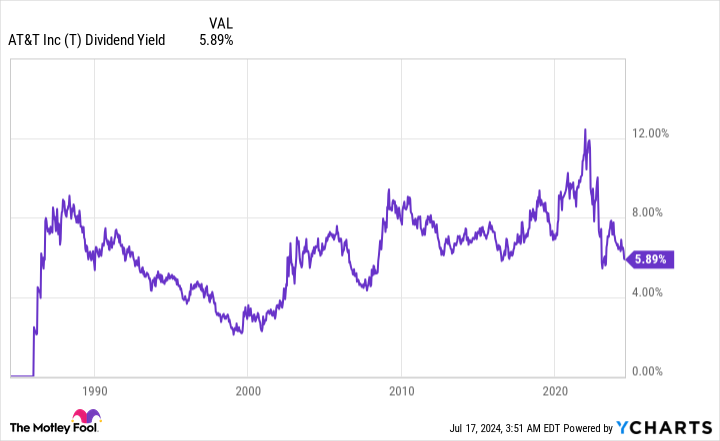For well over a century, Wall Street has provided a pathway for everyday Americans to secure their financial freedom. While the road to financial independence is full of twists and turns, patience tends to be handsomely rewarded.
Although there are a lot of ways to grow your wealth in the stock market, few strategies have proved as consistently fruitful over the long run as buying and holding top-notch dividend stocks.
In 2023, the researchers at Hartford Funds issued a report (“The Power of Dividends: Past, Present, and Future”) that examined the multiple ways income stocks have run circles around non-payers over extended periods. In particular, a collaboration with Ned Davis Research compared the performance of dividend stocks to non-payers over the prior half-century.

While the average non-paying stock has generated a modest 4.27% annualized return over 50 years, the typical dividend stock has more than doubled this average annual return (9.17%). Moreover, income stocks were 6% less volatile than the broad-based S&P 500, while the non-payers were 18% more volatile.
These results are in no way surprising. Companies that are regularly sharing a percentage of their earnings with investors are usually profitable on a recurring basis, time-tested, and capable of providing transparent long-term growth outlooks. They’re the type of businesses we’d expect to steadily increase in value over the long term.
However, no two dividend stocks are cut from the same cloth, which means proper vetting is required if you aim to land a high-quality, supercharged income stock.
Though some ultra-high-yield dividend stocks — companies with yields that are four or more times greater than the yield of the S&P 500 — are, indeed, yield traps, others are bona fide money machines. The following two beaten-down ultra-high-yield dividend stocks, which sport an average yield of 5.79%, fall into the latter category and are begging to be bought right now.
Time to pounce: AT&T (5.89% yield)
The first high-octane dividend stock that opportunistic investors can confidently pounce on after a sizable downdraft is none other than telecom titan AT&T (NYSE: T). Shares of the company are down more than 40% over the last eight years, which has boosted its dividend yield to almost 6%.


One reason AT&T has underperformed in the current bull market has to do with the Federal Reserve’s shift in monetary policy. Telecom stocks are often lugging around a lot of debt. The Fed’s steepest rate-hiking cycle in four decades means future refinancing and deal-making activity is bound to be costlier for AT&T and its peers.
Story continues
The other potential concern stems from a Wall Street Journal report in July 2023 that alleges U.S. telecom companies could face hefty cleanup and health-related liabilities tied to their use of lead-clad cables.
While these litigation worries shouldn’t be swept under the proverbial rug, AT&T has been adamant that its lead-sheathed cables aren’t a health hazard. Even if AT&T and its peers were to have some sort of financial liability in the future, a settlement figure would be determined by the notoriously slow U.S. court system. In other words, AT&T would still be years away from contending with any financial repercussions.
More importantly, AT&T’s balance sheet has noticeably improved since the spinoff of its content arm, WarnerMedia, in April 2022. When WarnerMedia and Discovery merged to create the new media entity we now know as Warner Bros. Discovery, it became responsible for certain debt lots previously held by AT&T. Including cash payments, AT&T enjoyed over $40 billion in various concessions. In the two years following March 31, 2022, AT&T’s net debt has gone from $169 billion to $128.7 billion.
Let’s be clear: AT&T still has work to do. In the coming years, it should be able to use its operating cash flow to chip away at its outstanding debt. But with its balance sheet on considerably firmer footing, there’s no question that the company’s $0.2775 quarterly dividend is safe.
The 5G revolution continues to be an organic growth catalyst for AT&T, as well. Upgrading its network to support faster download speeds has encouraged an ongoing device replacement cycle among consumers and businesses. The benefit for AT&T is that its customers are using more data — and data is where the company generates its juiciest margins.
Furthermore, first-quarter postpaid churn was a record-low 0.72%. This is a function of the company’s infrastructure upgrades resonating with consumers, as well as the fact that access to wireless services and the internet is now viewed as a basic necessity.
This is a good time to mention that AT&T’s broadband operations are firing on all cylinders, too. AT&T is working on what would be its seventh consecutive year of at least 1 million net broadband additions. While broadband is no longer the growth story it was in the early 2000s, it’s still a steady provider of cash flow and a service that can be used to coerce high-margin bundling among residential customers.
To round things out, AT&T’s stock remains a bargain. Even with modest long-term growth, a forward price-to-earnings (P/E) ratio of 8, coupled with a nearly 6% yield, is quite the deal.


Time to pounce: Pfizer (5.69% yield)
A second beaten-down ultra-high-yield dividend stock that income seekers can pounce on right now is pharmaceutical kingpin Pfizer (NYSE: PFE). Shares of the company are down roughly 50% in less than three years, which has lifted the company’s yield to 5.7%.
As I’ve previously pointed out, Pfizer fell victim to its own success. During the COVID-19 pandemic, it was one of a small number of drug companies that was successful in developing a vaccine. Pfizer’s COVID-19 vaccine (known as Comirnaty) and its oral treatment (Paxlovid), designed to reduce the severity of COVID-19 symptoms, collectively brought in more than $56 billion in sales in 2022.
In 2024, Pfizer has guided for its COVID-19 therapies to generate a combined $8 billion in sales. In just two years, it’ll have shed $48 billion in revenue from two of its top-selling products. That’s a bit of sticker shock for anyone, but it’s important for current and prospective investors to take a step back and recognize where Pfizer’s been and where it’s headed.
At the end of 2020, with the pandemic in full swing, Pfizer generated $41.9 billion in full-year sales. Based on the midpoint of the company’s full-year forecast this year, Pfizer is on track to deliver $60 billion in sales. Despite shedding $48 billion in full-year sales from its line of COVID-19 therapies, Pfizer’s annual revenue is pacing a 43% increase over a four-year stretch. That’s phenomenal growth for a mature pharmaceutical company.
To build on the above, Pfizer’s first-quarter operating revenue, sans COVID-19 therapies and excluding currency movements, increased by 11% from the comparable period in 2023. This demonstrates that Pfizer’s drug portfolio is in solid shape.
If you’re looking for superstars in Pfizer’s portfolio, blood-thinning drug Eliquis and prostate cancer therapy Xtandi fit the bill. Eliquis is pacing more than $8 billion in annual run-rate revenue and delivered 10% operating sales growth in the March-ended quarter. Meanwhile, sales for Xtandi surged 23%, with the drug tracking close to $1.7 billion in annual run-rate revenue.
Pfizer’s $43 billion acquisition of cancer drug developer Seagen in mid-December is another potential game changer. Seagen immediately adds north of $3 billion in annual oncology sales, and the combination of the two companies should yield meaningful cost-savings in 2025 and beyond. Best of all, Seagen’s pipeline is flush with therapies that can fuel growth at Pfizer for years to come.
Pharmaceutical companies are also highly defensive. Regardless of what’s happening with the U.S. or global economy, people still develop illnesses and require treatment. Demand for prescription medicines doesn’t stop just because the U.S. economy or stock market hits a rough patch. For Pfizer, this means predictable operating cash flow in pretty much any economic climate.
Lastly, the company’s valuation makes a lot of sense. Shares can be scooped up right now for less than 11 times forecast earnings per share in 2025. This represents a fair price for a wonderful company that sports an outsized dividend yield.
Should you invest $1,000 in AT&T right now?
Before you buy stock in AT&T, consider this:
The Motley Fool Stock Advisor analyst team just identified what they believe are the 10 best stocks for investors to buy now… and AT&T wasn’t one of them. The 10 stocks that made the cut could produce monster returns in the coming years.
Consider when Nvidia made this list on April 15, 2005… if you invested $1,000 at the time of our recommendation, you’d have $774,281!*
Stock Advisor provides investors with an easy-to-follow blueprint for success, including guidance on building a portfolio, regular updates from analysts, and two new stock picks each month. The Stock Advisor service has more than quadrupled the return of S&P 500 since 2002*.
See the 10 stocks »
*Stock Advisor returns as of July 15, 2024
Sean Williams has positions in AT&T and Warner Bros. Discovery. The Motley Fool has positions in and recommends Pfizer and Warner Bros. Discovery. The Motley Fool has a disclosure policy.
Time to Pounce: 2 Beaten-Down Ultra-High-Yield Dividend Stocks That Are Begging to Be Bought Right Now was originally published by The Motley Fool




















